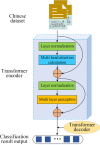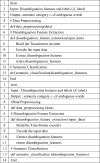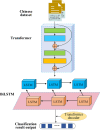Application of the transformer model algorithm in chinese word sense disambiguation: a case study in chinese language
- PMID: 38491085
- PMCID: PMC10943221
- DOI: 10.1038/s41598-024-56976-5
Application of the transformer model algorithm in chinese word sense disambiguation: a case study in chinese language
Abstract
This study aims to explore the research methodology of applying the Transformer model algorithm to Chinese word sense disambiguation, seeking to resolve word sense ambiguity in the Chinese language. The study introduces deep learning and designs a Chinese word sense disambiguation model based on the fusion of the Transformer with the Bi-directional Long Short-Term Memory (BiLSTM) algorithm. By utilizing the self-attention mechanism of Transformer and the sequence modeling capability of BiLSTM, this model efficiently captures semantic information and context relationships in Chinese sentences, leading to accurate word sense disambiguation. The model's evaluation is conducted using the PKU Paraphrase Bank, a Chinese text paraphrase dataset. The results demonstrate that the model achieves a precision rate of 83.71% in Chinese word sense disambiguation, significantly outperforming the Long Short-Term Memory algorithm. Additionally, the root mean squared error of this algorithm is less than 17, with a loss function value remaining around 0.14. Thus, this study validates that the constructed Transformer-fused BiLSTM-based Chinese word sense disambiguation model algorithm exhibits both high accuracy and robustness in identifying word senses in the Chinese language. The findings of this study provide valuable insights for advancing the intelligent development of word senses in Chinese language applications.
Keywords: BiLSTM; Chinese language; Root mean squared error; Transformer model algorithm; Word sense disambiguation.
© 2024. The Author(s).
Conflict of interest statement
The authors declare no competing interests.
Figures










Similar articles
-
Biomedical word sense disambiguation with bidirectional long short-term memory and attention-based neural networks.BMC Bioinformatics. 2019 Dec 2;20(Suppl 16):502. doi: 10.1186/s12859-019-3079-8. BMC Bioinformatics. 2019. PMID: 31787096 Free PMC article.
-
Improving clinical abbreviation sense disambiguation using attention-based Bi-LSTM and hybrid balancing techniques in imbalanced datasets.J Eval Clin Pract. 2024 Oct;30(7):1327-1336. doi: 10.1111/jep.14041. Epub 2024 Jun 21. J Eval Clin Pract. 2024. PMID: 39031903
-
A comprehensive dataset for Arabic word sense disambiguation.Data Brief. 2024 Jun 4;55:110591. doi: 10.1016/j.dib.2024.110591. eCollection 2024 Aug. Data Brief. 2024. PMID: 38966662 Free PMC article.
-
Word embeddings and recurrent neural networks based on Long-Short Term Memory nodes in supervised biomedical word sense disambiguation.J Biomed Inform. 2017 Sep;73:137-147. doi: 10.1016/j.jbi.2017.08.001. Epub 2017 Aug 7. J Biomed Inform. 2017. PMID: 28797709
-
Word sense disambiguation in the biomedical domain: an overview.J Comput Biol. 2005 Jun;12(5):554-65. doi: 10.1089/cmb.2005.12.554. J Comput Biol. 2005. PMID: 15952878 Review.
Cited by
-
Linguistic-visual based multimodal Yi character recognition.Sci Rep. 2025 Apr 7;15(1):11874. doi: 10.1038/s41598-025-96397-6. Sci Rep. 2025. PMID: 40195531 Free PMC article.
References
-
- Bharadiya J. A comprehensive survey of deep learning techniques natural language processing[J] Eur. J. Technol. 2023;7(1):58–66. doi: 10.47672/ejt.1473. - DOI
-
- Xu N, Ma L, Wang L, et al. Extracting domain knowledge elements of construction safety management: Rule-based approach using Chinese natural language processing[J] J. Manag. Eng. 2021;37(2):04021001. doi: 10.1061/(ASCE)ME.1943-5479.0000870. - DOI
-
- Zheng Z, Lu XZ, Chen KY, et al. Pretrained domain-specific language model for natural language processing tasks in the AEC domain[J] Comput. Ind. 2022;142:103733. doi: 10.1016/j.compind.2022.103733. - DOI
-
- Pan DJ, Lin D. Cognitive–linguistic skills explain Chinese reading comprehension within and beyond the simple view of reading in Hong Kong kindergarteners[J] Lang. Learn. 2023;73(1):126–160. doi: 10.1111/lang.12515. - DOI
-
- Guo H. Chinese primary school students’ translanguage in EFL classrooms: What is it and why is it needed? [J] Asia-Pacific Educ. Res. 2023;32(2):211–226.
LinkOut - more resources
Full Text Sources

